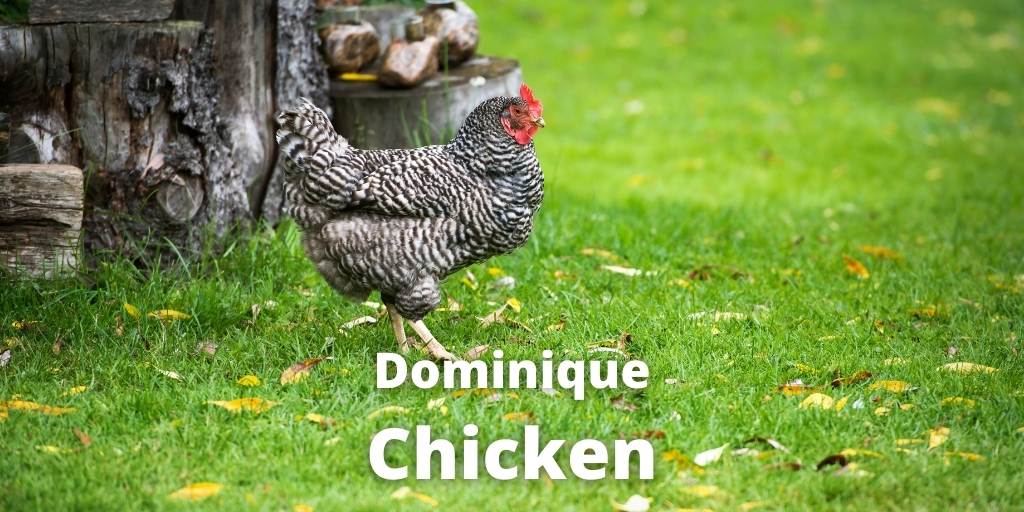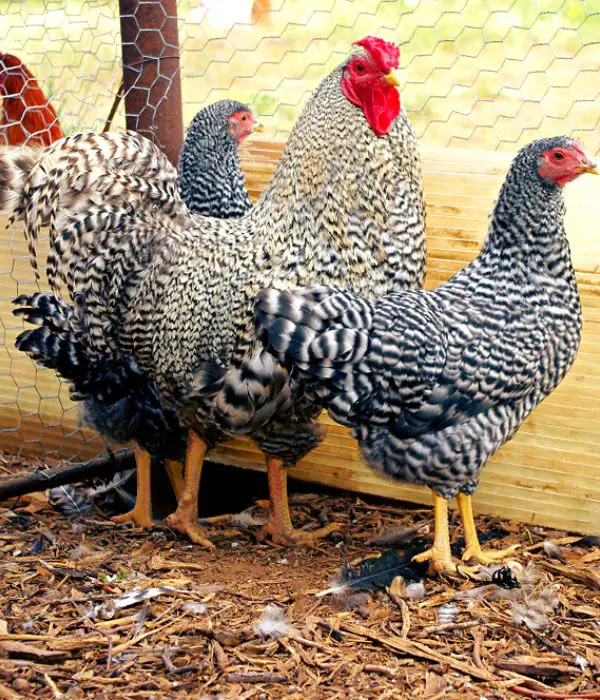
Dominique chickens are the ideal dual-purpose chicken. Many chicken owners like to raise this unique chicken breed.
People keep them for meat and eggs but use their feathers to stuff pillows. Most chicken keepers want to add them to their flock because of their multi-purpose use.
In this article, you will learn everything you need about Dominique chickens. This includes general features, history, lifespan, egg production, size, temperament, appearance, benefits, and problems with raising Dominique’s.
What is Dominique Chicken?
It is said that the oldest chicken breed in the US is the Dominique Chicken. The chicken lovers brought it to the United States, and the settlers helped them survive during the first year of colonization.
Dominique Chicken is also known as pilgrim fowl, and their feathers are used to stuff the pillows. It is a breed of chicken that originated in the United States in the colonial period.
This multi-purpose chicken breed is valued for its meat, brown eggs, and amazing soft feathers. Dominique is quite famous and was raised in many parts of the country during the 19th century.
Feathers from Dominique chickens are softer and are used as stuffing for pillows and mattresses.
History and Origin

This is the conventional American breed of chicken known to be brought by the settlers in the eastern USA since the 1750s. They are thought to be brought by a pilgrimage to the USA; therefore, they are also known as Pilgrim fowl.
Dominique was first seen in the United States, especially in the northeast around Boston. After the Plymouth Rock breed was developed from Dominique’s in 1870.
The first timeline of decline was in the 1920s when it survived its first depression during the First World War. Many people keep this chicken because it is hardy and saves money.
The Dominique chicken crisis happened a second time because of the Industrial Revolution. This revolution made the poultry industry more industrial and mechanical.
The American Livestock Breed Conservancy considered this Dominique chicken to be in critical condition in the 1970s, with fewer than 500 birds in North America.
Due to their revival of interest, they have returned and are now listed on the watch list, indicating the lesser danger of extinction.
Even though the bird’s exact origin is unknown, the chicken breed is indispensable to the early settlers as it was a hardy little bird that forged its existence.
Many rumors about Dominique chicken come from the story of a French colony called Saint Dominique, now called Haiti, and it seems like the name Dominique came from this story.
Common Names of Dominique Chicken
Dominique chickens are known by various names all over the globe. Here are some of the popular names of this breed-
- Old spotted hen
- Old gray hen
- Pilgrim fowl
- Dominic
- Dominicker
- Blue Spotted Hen
Dominique Chicken Lifespan
Usually, Dominique chickens live for about 6-8 years, but this depends on how well they are cared for. They have a good life expectancy as dual-purpose chickens.
Eggs Production
Dominique hens produce 4 eggs in a week. Dominique is one of the best egg-laying chicken breeds, which lays medium-sized light-brown eggs.
They lay around 230-270 eggs per year. A Few Dominique hens occasionally go broody; they are excellent mothers and attentive to their chicks.
Their success rates in raising their chicks are high. The Dominique chicks are auto-sexing and could easily be classified upon hatching.
Most Dominique chicks have white spots on their heads; in females, these spots are small and concentrated, while in males, they are more diffused and scattered.
Here is the list of chickens that lay colored eggs.
Dominique Chicken Temperament
These chickens seem peaceful, which is why people enjoy this breed. Dominique chickens only fight when threatened.
This chicken breed is peaceful and friendly. Dominique is a hardy bird that can survive any conditions.
This breed of hens is calmer and friendlier to poultry owners. Independent breed hens appreciate free-ranging.
Color, Size, Appearance, and Characteristics of Dominique Chicken

Color
Dominique chickens have black and white stripes (bars) on their feathers. The black and white barred pattern is the only accepted color variety in the US.
They look like Barred Rock chickens, but the major difference is Barred Rock has a straight comb, and Dominique has a rose comb with spikes.
Size
Dominiques are medium size chickens. Weights of hens and roosters will be approximately 5 to 7 lbs. The male and female will weigh around 7 and 5 lbs, respectively.
Bantam Dominique is also available; the male weighs around 1.75 lbs, and the female weighs around 1.5 lbs.
Appearance
The chicken’s body is well-rounded, broad, and medium. The wings are large, have round, full breasts, and have a whitish head spot.
Female chicks have small, concentrated spots, while males have bigger, more spread-out spots. Dominique chicks are auto-sexing, so they are easily classified after hatching.
Dominique chickens have a unique and attractive appearance. Light gray feathers may be present as they have dark and gray feathers. At six months of age, the hens of this breed start laying eggs.
Characteristics
Dominique can be easily recognized by its rose comb and barred feather pattern. This chicken has a mottled appearance because of the slate and light bars.
Dominique chicken has a contrast of not quite black or white color. Also, they have yellow legs with four toes. The skin is yellow, with bright red wattles, a red comb, and earlobes.
The long sweeping tail of roosters is beautiful, whereas the hens have plump breasts and high tails.
The rooster weighs 7 lbs, and the hen weighs 5 lbs. Dominique hens are good layers and lay brown-colored eggs.
The Difference in Appearance Between Dominique & Barred Rock Chicken

To make it easy, first, we should understand that Barred Rock is not a breed; Plymouth Rock is the breed. Dominique is a chicken breed.
Dominique and Barred Rock are both dual-purpose chickens, so they are popularly used for eggs and meat.
Dominique’s chicken has a rose comb, whereas Barred Rock has a straight comb.
The chickens look similar, but their feathers have different patterns. Dominique has very irregular pattern bars, and Barred Rock has straight lines.
The color of Dominique’s chickens is brighter than Barred Rock. Dominique chickens are smaller than Barred Rock.
The eggs of Dominique chickens are smaller than those of Barred Rock chickens, but they are the same light-brown color.
Benefits of Raising Dominique Chicken
Dominique is non-aggressive and gentle to children. These breeds are easy to care for and good for beginners who want to raise chickens. These birds grow faster than others and can survive in bad weather conditions.
Dominique chickens are easy to tame and are very calm and easygoing. They have a unique, frenzied appearance and behave relaxed, laid-down. Dominique hens go broody and are good mothers.
Although they have ridiculous feathers, they still show their love and care for their younger ones. Since these chickens are medium, they don’t need much extra space in the chicken tractor.
Problems in Raising Dominique Chicken
This Dominique breed seems destined to sink into oblivion. Most of the chickens of this breed are calm and docile and have a steady demeanor; that’s why they are used as a pet chickens.
Dominique chickens’ docile nature can become dangerous because predators can easily attack and kill them. Some are quite aggressive, and they are known to be more aggressive than Rhode Island Red.
They have been known to kill small animals like cats, mink, and even snakes. The roosters are very aggressive, especially during the mating season, but not aggressive to their keepers.
Care Tips for Dominique Chicken
There are four major things we should check on raising this chicken breed – feeding, coop and run, and roaming:
- We should first think about their enclosure. These birds are free-range. They should be able to go somewhere for free-ranging and safely when they want to. We should have plenty of space for these birds.
- Dominique needs more feeding. Most of the chickens need two times more food a day.
- Give your chicken constant access to fresh water. We should take care of the water, as we have to change it if it gets dirty. We know chickens are dirty, so we must change the water twice daily.
- We should provide proper coop heaters, which are responsible for our survival.
Summary
Dominique is a charming and delightful chicken. Dominique is a calm bird, happy to free-range or hang out with other birds in a cage. It is difficult to beat as an exhibition bird.
There are many offers in the way of gentle, quiet companions. Dominique was so well-behaved. Many poultry raisers keep the Dominiques as house pets.
It’s a delight to see them; they are simultaneously non-demanding and happy.


Leave a Reply